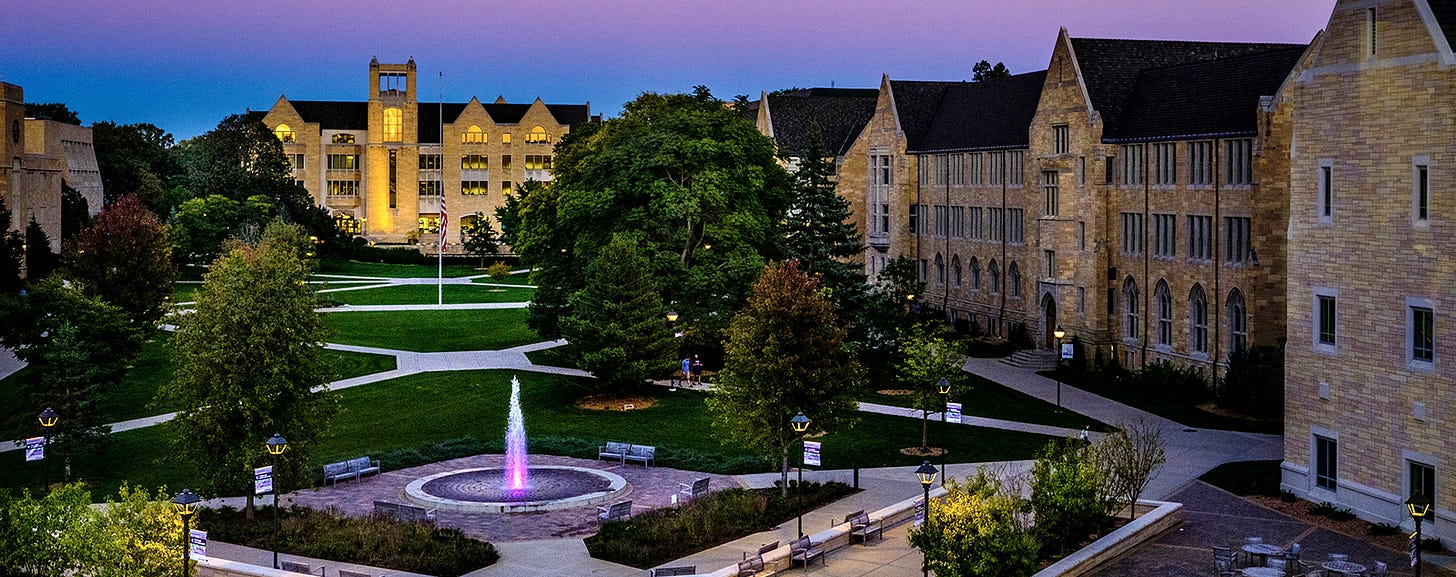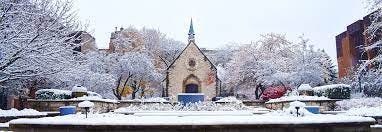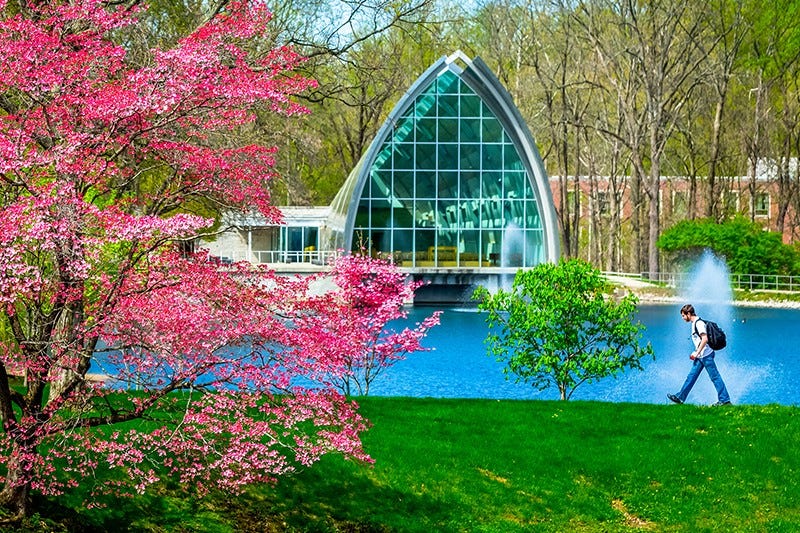Retention - private colleges in the Upper Midwest
Our retention series resumes. Who is undervalued? Troubled?
The upper Midwest region - Minnesota, Illinois, Wisconsin, Indiana and Michigan - presents students with many college choices, so many that it can be difficult to navigate the thicket of options and make sense of undergraduate programs, their value and their risk. This post resumes our survey of retention results and provide some highlights – and lowlights – for private colleges from Minnesota stretching southwards to Indiana. The colleges were screened to exclude small programs with enrollment below about a thousand students. Even then, over 80 colleges remain, with a wide variety of profiles and levels of selectivity. We will review the retention and admissions results state by state to organize and make sense of the wealth of options students have.
The first thing to note is that the higher ed ecosystem in this region is pretty healthy. Last year, we’d looked at the situation in the upper Great Plains, noting that the supply of college seats far exceeded the number of students, leaving a whole group of private colleges gasping for students. This situation fortunately doesn’t exist in the upper Midwest. While some colleges are posting disappointing results, there isn’t the sort of cluster of troubled schools seen in the Plains area.
How do we know whether a college is running an effective undergraduate program? Retention – the % of first year students returning for a second – offers an up-to-date metric. While it isn’t the be-all-and-end-all - other measures and information are important in “grading a program” - retention offers a bottom-line result measuring whether students can do the course work, can afford to pay for the program and, finally, like what they are getting from the college. While 4- and 6-year graduation rates are another good metric, the reports are published with a major lag. Retention appears more quickly. Because retention at different classes of institutions isn’t comparable, this series tries to decompose what retention is telling us about schools in a given category and region to allow for valid comparisons and to draw some lessons.
Minnesota – a high-performing liberal arts segment
Carleton, Macalester and St. Olaf’s, likely the best-known liberal arts colleges in Minnesota, all post superior retention results. What about the other colleges?
Three of their denominational neighbors, with much lower levels of selectivity, strongly outperform in terms of retention:
By far the largest private college in the state, St. Thomas, in the Twin Cities, retains students in the high 80% range, exceeding what you’d expect from a school with an 80% admit rate.
St. Benedict and nearby St. John’s rival St. Thomas’ results with a smaller program size. These schools are similarly easy to get into, but keep their students.
The two disappointments are both located in the Twin Cities: Concordia-St. Paul saw significant enrollment challenges in the cycles right before COVID, and Augsburg University has seen sharp declines in both selectivity and enrollment. Neither is quite at a level flashing warning signals, but further deterioration could affect their competitiveness.

Comparing these results with other states, it’s clear that Minnesota’s higher ed system is in very good shape, with the bulk of the institutions posting satisfactory retention -- and a few doing better than that.

Wisconsin – private colleges in a state dominated by publics
Wisconsin has one of the more unusual higher ed systems among the states covered here, with a heavy reliance on the UW network and other public universities instead of an underdeveloped private system. In 2019, just over 6,000 incoming students matriculated at a private college in Wisconsin out of over 70,000 high school graduates, a very small proportion, pointing to the small role the private sector plays.
None of the college post outstanding retention, but Marquette’s reputation as a quality program is supported by its outperformance here. Its 89% retention average in 2016-19 would generally be associated with a program admitting under half of its applicants; Marquette admits over 80%. Perhaps one factor driving down applications and student interest is Marquette’s high incidence of crime, which recently led the school’s president to launch a task force focused on that issue. The harsh lakefront weather likely doesn’t help.
Wisconsin’s results are generally in line with averages but Lawrence University in Appleton reports above average results. Lawrence is also a notably well-endowed school with easily the largest war chest per student of any college in the state. This helps with financial aid, amenities and educational spending.

Illinois
Illinois’ well-known difficulties retaining its own high school graduates seems to spill over into its private retention results. With one exception, none of the fairly large number of institutions posted really outstanding results when compared to their admit percentage.
Wheaton College, an evangelical institution in the western suburbs of Chicago, is the only Illinois school besides the two elite institutions, Northwestern and the University of Chicago, to break the 90% retention threshold. Wheaton’s combination of light selectivity (85% of applicants were admitted in 2019) and high yield (38% of those admittees enrolled!) relies on a dedicated and religious student base. Not for everyone but it makes for a very successful undergrad program. By now, with similar results in states like California and Minnesota, it’s becoming clear that explicitly religious schools or ones with a denominational tradition and focus are generally outperforming on the retention front. While trying to be careful about hypothesizing, it is tempting to speculate that students are self-selecting into the applicant base.
The results for Robert Morris University in Chicago are from 2016-2019, prior to its 2020 closure, when its programs were either closed or bought by Roosevelt University. Its recruiting difficulties were being reported on before COVID and the retention numbers underscore a precarious situation. The school had been very reliant on Asian recruiting, a risk-filled situation in normal times and an untenable one during the pandemic. With fewer than 50% of full-time students returning for a second year in the period measured here, the university had reached a level of instability that doomed it.
Three of the state’s largest private programs – DePaul, Loyola and Bradley – are essentially identical in commercial terms. They admit ~70% of applicants, virtually everyone receives a steep discount, and about 85% of first years return. The two Chicago city ones, Loyola and DePaul have similar pricing, indicating competition between the two; Bradley, located in smaller Peoria, is cheaper. The Chicago upcharge is worth about $7-9k to students.
Although Chicago schools like Roosevelt and Columbia post subpar retention, the really disappointing result originates from Benedictine University, in Chicago’s southern suburbs. Its admissions stats fluctuate widely year to year, indicating recruiting challenges, and the school then routinely loses 30% or more of those first years before the next fall. Additionally, branch expansions and partnerships with Chinese universities have had mixed results. We were unable to find any rumors of financial struggles but there has been churn in its executive offices.
Earlier in our series, we’d pointed to how Concordia-Portland experienced retention issues that led to its closing, in the same period as Robert Morris. Benedictine displays a similar selectivity/retention profile as Concordia.
While the upper Midwest generally shows nice results with many healthy programs, the Illinois numbers support anecdotal observations of the state’s high schooler postsecondary preferences (they want to move out) and its consequently weak higher ed ecosystem.

Michigan
When contrasted with Michigan, Illinois’ disappointing performance is apparent. Michigan is home to 3 schools with retention rates above 90% and one, Hope College in Grand Rapids, that falls just short of that threshold with 89%.
Kettering University (not to be confused with Kettering College in Ohio) shows up as one of the big values emerging from this analysis. Located in Flint, it is a co-op driven program like Northeastern in Boston, with external work assignments required for graduation. The retention results shown above, an average of multiple years, actually represent a decline from prior results. Kettering was retaining 95% of its students in 2016, amazing for a school with a ~70% acceptance rate. (The data point above is an average of 2016-19, so slightly lower.) The other strong outperformer here is Kalamazoo College. Based on how their students are behaving, both schools appear to be running high quality programs.
Hillsdale College, a self-consciously politically conservative program with just over 1,000 undergrads, is the only Michigan private school with an admissions rate under 50% and posts exceptionally strong retention results for this selectivity level.
Baker College, the subject of a negative story in Inside Higher Ed in January 2022, looks to be in the process of an unwind. With retention below 50%, it is in a similar position to Robert Morris in Chicago. (We need to comment that the IHE story is disappointingly confused. Financial aid is not “spending” in the same way something like marketing is.)
The other really concerning result came from Adrian College, near the Ohio border. Adrian has been in the news due to faculty employment controversies and internal complaints about financial management.

Indiana
The Hoosier state delivered among the more surprising results covered here. No, not Notre Dame, which has been climbing into the highly selective category for several years now and shows retention stats nearly indistinguishable from the likes of Yale and Duke.
The surprise came from the two big mid-state universities, DePauw and Butler. Both admit 65-75% of applicants but report strong retention results of around 90%. Quick quiz: what were the top 4 Indiana schools in terms of pre-COVID SAT/ACT performance? We hope for your sake you can’t answer that question! But the answer emerges from the chart below. The top 4 in board scores are the top 4 in retention (ND, Rose-Hulman, Butler & DePauw). DePauw is also helped by its outsize endowment.
How institutional giving is just so consistently slanted towards the rich schools is paradoxical. Notre Dame’s endowment is roughly 4x the total endowments of all the other private colleges in Indiana combined. We saw the same phenomenon with Stanford in California. Why do rich benefactors so prefer to add to the swollen foundations of the leading universities instead of donating to quality smaller schools? Puzzling, but there has to be a good reason for it. At least Mackenzie Scott is aware of the issue.
The Rose-Hulman Institute of Technology presents an interesting case. Located near the Illinois border west of Indianapolis, its retention of 91% is excellent for any program and especially so for one that is moderately selective. But Rose-Hulman is trending in a negative direction, with admissions standards falling and retention drifting downwards with it. A value for students or one deteriorating in the face of enrollment pressure? We’ll have to see.
Like Michigan, Indiana also hosts two troubled universities, Anderson and Manchester, in the farmlands of the state’s northeast. Anderson has managed to maintain its selectivity over the last few years but both its yield and retention results are plunging. Manchester has reported consistently below average results for several years now. With low yields and low retention, these universities are in difficult commercial situations, although not on the same scale as Baker or Robert Morris.

Takeaways
Statistically, Notre Dame is closing the gap with Northwestern and the University of Chicago when we look at the highly selective schools. For one, Notre Dame’s yield is equivalent to Northwestern. Smaller Carleton falls just behind them.
Although the upper Midwest shows a healthy higher ed ecosystem, unlike the Great Plains, certain institutions – from Adrian and Baker in Michigan to Benedictine in Illinois to Manchester in Indiana – face commercial headwinds that certainly put in doubt their longevity.
For politically and religiously conservative students, the region offers two programs with superb performance, Hillsdale in Michigan and Wheaton in the Chicago suburbs. Several denominational and explicitly Christian colleges also present well.
The “surprise contestant” emerging from these numbers is Kettering University in Michigan. Despite a limited endowment, it is displaying a stable recruiting position and continues to deliver very strong program metrics. The Rose-Hulman program in Indiana is similarly STEM focused and has a record of achievement, but its deteriorating recruiting position raises the possibility of future issues. Small colleges like Kalamazoo and Gustavus Adolphus in Minnesota come out looking great, too.
These are the private institutions. How does this compare with the many big public universities in the region? That will be the subject of our next installment.
Find more information at the CTAS site.






